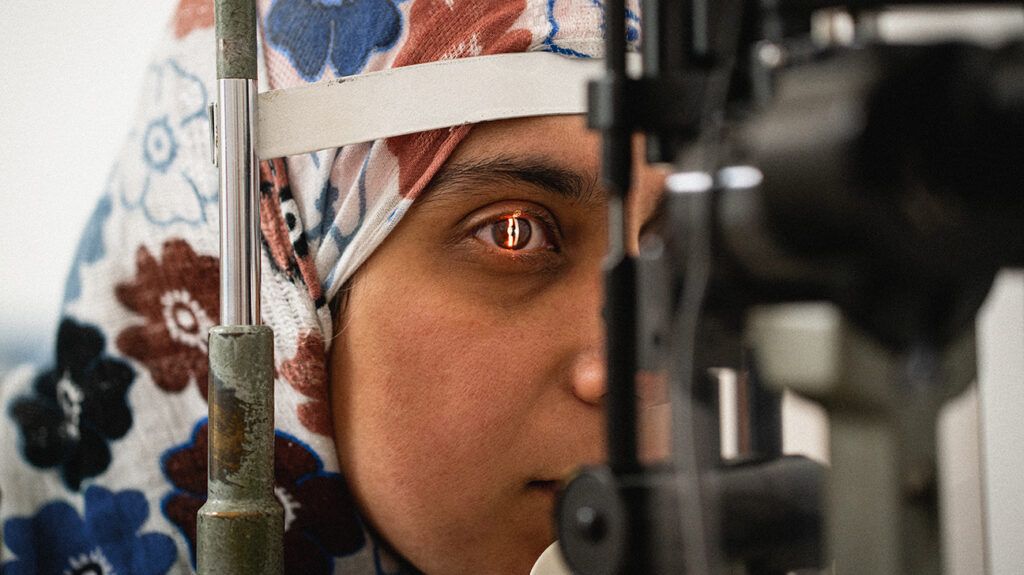Ankylosing spondylitis (AS) is a rare form of inflammatory systemic arthritis that mainly affects the back. Because AS is a systemic condition, which can affect the whole body, inflammation relating to it can affect other areas, including the eyes.
As with other types of arthritis, there is no cure for AS. Treatment focuses on relieving the symptoms, slowing the progression of the condition, and preserving the quality of life.
A person with AS needs to be aware of how it can affect their eyes. They also need to speak with a doctor if they have any eye issues.
Below, learn about some common conditions that someone with AS may experience and some general tips for supporting eye health.

Anterior uveitis, also known as iritis, is inflammation of a part of the eye called the uvea. The uvea sits toward the middle of the eye.
Anterior uveitis is one of four types of uveitis, and the
According to one 2017 study, as many as 40% of people with AS develop acute anterior uveitis.
The HLA-B27 gene
Without treatment, anterior uveitis may lead to permanent damage and possibly blindness. However, with early intervention, a person’s outlook is generally positive.
Symptoms
Anterior uveitis causes swelling or inflammation in the eye. As the Spondylitis Association of America notes, anterior uveitis causes:
- pain
- redness
- light sensitivity
- issues with vision
The symptoms usually affect one eye at a time and can take a
Treatment
Treatments can vary according to the severity of the condition. Doctors typically recommend treating anterior uveitis with corticosteroid eye drops and other drops to dilate the eye.
If drops do not work, the doctor may administer corticosteroid injections.
Treating the underlying AS with biologic drugs called tumor necrosis factor inhibitors can help prevent anterior uveitis.
A person can speak with a doctor about any symptoms of anterior uveitis. They may make a referral to an optometrist or ophthalmologist, who can rule out other possible conditions and administer treatment. If any symptoms do not improve, an individual can let the doctor know.
Glaucoma is actually a group of conditions that put pressure on the optic nerve. This can cause damage that leads to vision issues and potentially vision loss.
The Arthritis Foundation notes that anyone with an inflammatory type of arthritis, such as AS, has an increased risk of glaucoma. Those who use corticosteroids also have a higher risk of these eye conditions.
Symptoms
A person typically
In later stages, the condition causes a slow loss of peripheral vision.
Without treatment, it can eventually cause blindness. Receiving treatment early can help prevent damage and preserve vision.
Treatment
There are three main types of treatment for glaucoma:
- Medications: These are often eye drops, which can help reduce pressure in the eye and prevent damage to the optic nerve.
- Laser treatment: Doctors typically use this to help drain fluid from the eye and relieve pressure.
- Surgery: This can help reduce pressure by draining fluid from the eye when eye drops or laser treatments are ineffective.
A person with AS needs to tell their doctor about any changes in vision. While glaucoma treatment cannot restore lost vision, early treatment can help prevent the issue from getting worse.
Cataracts cause the lens of the eye to become cloudy as a result of inflammation and pressure.
People who have genetic variations relating to inflammatory conditions, such as AS, have a higher risk of developing cataracts. In addition, taking steroids to treat health conditions can increase the risk of developing this eye problem.
Symptoms
Symptoms
- cloudy or blurry vision
- double vision
- low night vision
- colors appearing faded
- sensitivity to light, from the sun, lamps, or headlights
- lights seeming to have halos
- a need for frequent changes in glasses prescriptions
Over time, cataracts can lead to vision loss.
Treatment
A person with AS needs to let their doctor know about any vision changes, which may result from cataracts.
An eye doctor, such as an optometrist or ophthalmologist, can diagnose the issue, provide treatment, and recommend management techniques. The plan may involve:
- new glasses or contacts
- small changes at home, such as having brighter lights or using magnifying devices when reading or working
- surgery to remove the cloudy lens and replace it with an artificial lens
Anyone with AS needs to speak with a doctor about the risk of cataracts. An eye doctor can check for this issue during routine eye exams by dilating the eyes.
Learn more about ankylosing spondylitis
For people with AS, having regular eye checkups is important. It can help catch related eye conditions early and prevent damage or vision loss.
Individuals also need to let the doctor know about any changes in vision, including sensitivity to light, blurriness, or eye pain. These can be symptoms of an eye condition.
Receiving treatment early can help improve the prognosis for anterior uveitis and glaucoma.
AS is a systemic type of arthritis that primarily affects the back, but it can cause issues in other areas, including the eyes.
The most common eye condition relating to AS is anterior uveitis, but glaucoma and cataracts also have links to this form of arthritis. Early detection and treatment can help preserve vision.
